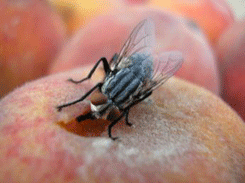Fearless Flyer
Air Date: Week of November 4, 2005

Rafal Zbikowski is making a science out of the common housefly. A professor at Cranfield University in England, Zbikowski hopes to develop a micro-air vehicle that could mimic the highly agile flight patterns of flies. Jean Kumagai from Spectrum Radio reports.
Transcript
GELLERMAN: When it comes to sheer, gravity-defying aerobatics, nothing beats the common housefly. It can buzz around the room at six miles an hour, and turn six full rotations in just a second. Let's see you do that.

KUMAGAI: Rafal Zbikowski never intended his career to end up this way, but these days he finds himself thinking, reading, and writing almost exclusively about houseflies.
ZBIKOWSKI: I’m an engineer by training, and I don’t have an idle interest in flies.
KUMAGAI: Zbikowski, a researcher at Cranfield University's Royal Military College of Science in England, is interested particularly in what makes the fly the world’s greatest aerial engineer.
ZBIKOWSKI: It can accelerate rapidly up to two times the acceleration of gravity in linear motion. But the real achievement is when it does rotations. It can rotate very rapidly – it can do six turns in a second, and it can achieve these six turns from rest in two hundredths of a second.
KUMAGAI: Zbikowski's interest in how flies fly is more than academic. He's hoping to build a micro air vehicle, or MAV, that mimics insect flight right down to the flapping wings.
ZBIKOWSKI: The idea was to have something that would be handheld and could fly. Handheld so that it could be easily carried around by an individual soldier, or a civilian, if there was a need for inspection. Because we have so many other things that can do outdoor reconnaissance, from satellites, to aircraft, to unmanned air vehicles and so on, but there is the problem of inspecting things inside. For example, the state of the art for inspecting pipes pumping noxious stuff is to send a fellow with a mirror on a stick looking for cracks. But if a crack is already there, he would inhale and we don't want that.
KUMAGAI: So far, researchers have had little success replicating the fly's agile movements. But they hope to learn how to by studying the insect's flight control system. Zbikowski says his research indicates is that flies use a completely different method for controlling their flight than would, say, an F-35 fighter jet.
Three Power PC computers running over a million lines of software code control the F-35's aeronautics, while the fly's flight commands emanate from a tiny part of its brain - a small knot of neurons with the computational power of your kitchen toaster. But the fly and the F-35 still have to obey the same laws of physics, so whatever the fly is doing in midair must be equivalent to the F-35's elaborate computations.
ZBIKOWSKI: Instead of computing the required information, the insect must somehow obtain it by different means, and this means sensors. In particular, their vision is very important. They will see patterns of interest and then fly toward these patterns, and therefore, things around them will streak past them, either along or around them. And from this they are able to infer their speed relative to this interesting object they are flying towards.
KUMAGAI: To explore their theories about insect flight, Zbikowski and his colleagues at Oxford and Cambridge Universities are beginning a series of experiments that, on the face of it, sound quite bizarre. First, they're constructing a miniature IMAX theatre, complete with a panoramic screen, inside of which they'll place a tiny rotating cage, a mini-version of the ones astronauts use to simulate the tumble of reentry from space. Then they'll strap a fly into the cage and show it a movie.
ZBIKOWSKI: In principle, this will be a flight simulator which will, again, move the insect through all the motions that it would experience in flight. We need to do both experiments and theory because, in order to understand all this, we have to describe this mathematically.
KUMAGAI: Once their experiments are completed, which could take several years, Zbikowski believes they will know enough to begin constructing a truly insect-like flying robot. Given that such a small, unlovely creature like the fly can teach us so much, will we pack away our fly swatters? Hmm. Probably not. For Living on Earth, I'm Jean Kumagai.
Links
Living on Earth wants to hear from you!
Living on Earth
62 Calef Highway, Suite 212
Lee, NH 03861
Telephone: 617-287-4121
E-mail: comments@loe.org
Newsletter [Click here]
Donate to Living on Earth!
Living on Earth is an independent media program and relies entirely on contributions from listeners and institutions supporting public service. Please donate now to preserve an independent environmental voice.
NewsletterLiving on Earth offers a weekly delivery of the show's rundown to your mailbox. Sign up for our newsletter today!
 Sailors For The Sea: Be the change you want to sea.
Sailors For The Sea: Be the change you want to sea.
 The Grantham Foundation for the Protection of the Environment: Committed to protecting and improving the health of the global environment.
The Grantham Foundation for the Protection of the Environment: Committed to protecting and improving the health of the global environment.
 Contribute to Living on Earth and receive, as our gift to you, an archival print of one of Mark Seth Lender's extraordinary wildlife photographs. Follow the link to see Mark's current collection of photographs.
Contribute to Living on Earth and receive, as our gift to you, an archival print of one of Mark Seth Lender's extraordinary wildlife photographs. Follow the link to see Mark's current collection of photographs.
 Buy a signed copy of Mark Seth Lender's book Smeagull the Seagull & support Living on Earth
Buy a signed copy of Mark Seth Lender's book Smeagull the Seagull & support Living on Earth

